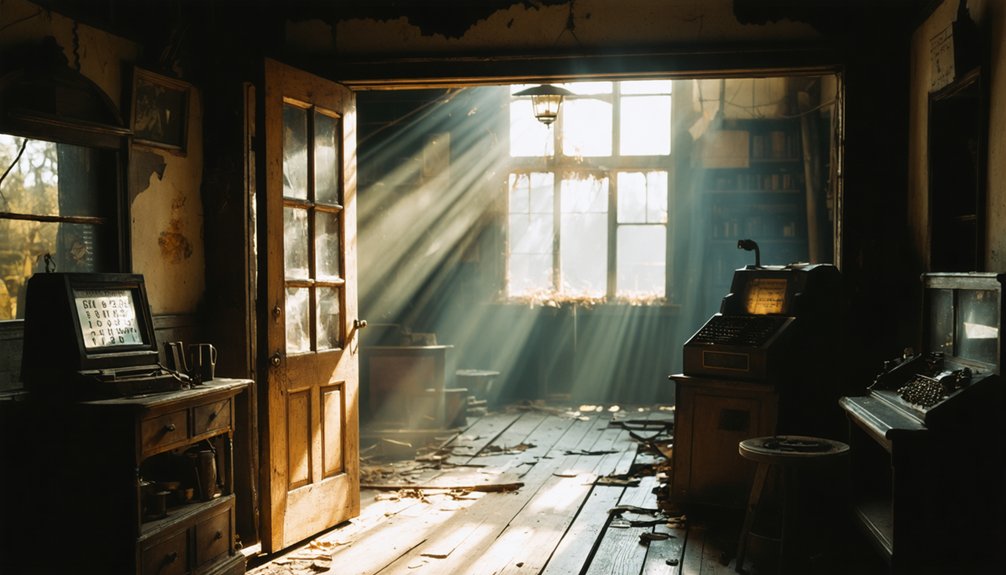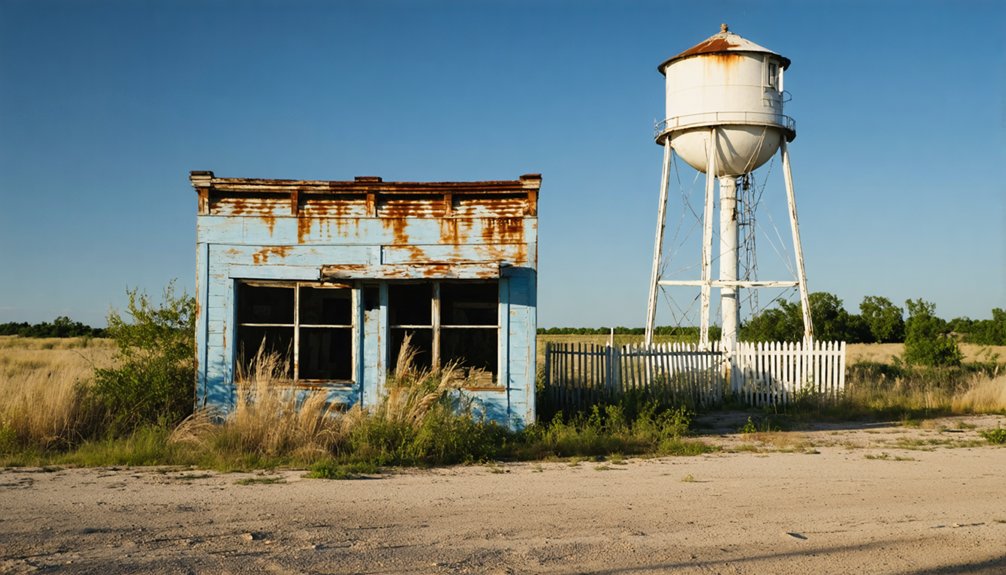You’ll find Gilliland, Texas in Knox County, where it began as a settlement called Coyote in the mid-1800s. The town peaked at 120 residents in 1947, thriving on cotton production and local businesses. After losing its high school in 1948, Gilliland gradually declined to just 25 residents by 2000. Today, abandoned structures like the school, gym, and local store stand as silent witnesses to this once-vibrant farming community’s fascinating past.
Key Takeaways
- Gilliland, Texas transformed from a thriving cotton-farming community into a ghost town, with population declining from 120 in 1947 to 25 by 2000.
- The town features abandoned structures including a school, gym, local store, and auto repair shop, all showing significant decay.
- Originally named Coyote, the settlement was renamed Gilliland in 1907 after district judge W.A. Gilliland when establishing its post office.
- Economic decline began after losing its high school to Munday in 1948, followed by widespread business closures and urban migration.
- Historical artifacts remain throughout the town’s structures, offering an authentic glimpse into small-town Texas decline without tourist commercialization.
A Pioneer Settlement Takes Root
While numerous Texas settlements emerged in the mid-1800s, Gilliland’s roots took hold when Anglo pioneers discovered the area’s abundant timber and clear water resources.
You’ll find that early settlers, many from Tennessee, Kentucky, and other southern states, quickly established pioneer infrastructure through land grants and colonization projects.
The Gilliland family played a significant role in community governance, with James Gilliland serving as both county commissioner and postmaster at Blue Hill.
As families arrived, they built essential institutions like the Moss Spring schoolhouse, constructed by the Harrell brothers.
You’d have seen a tight-knit community forming as settlers engaged in farming, opened tanneries, and established taverns.
Swedish immigrants joined the settlement in the 1850s, adding to the area’s cultural diversity and economic growth.
The discovery of oil reserves in the early 1900s brought newfound prosperity to the Gilliland family and transformed the local economy.
The Gilliland name gained further prominence when Sarah Miranda Gilliland Elliott became the third wife of notable Dallas County Sheriff Norvell Robertson Winniford.
From Coyote to Gilliland: The Town’s Evolution
Deep in Knox County, the settlement originally known as Coyote emerged when the first white settlers established their homesteads in the region.
Around 1890, Norwegian families from Bosque County made their way to this frontier outpost, bringing new energy to the fledgling community.
You’ll find the town’s educational roots stretching back to 1892 when the school district formed, with classes beginning in 1895 under teacher Oma Aker.
The most significant shift in the town’s identity came in 1907 when O.M. Olson opened a post office in his home. He named it after district judge W.A. Gilliland, and soon the entire settlement adopted this new name, forever leaving its Coyote origins behind. A cotton gin was constructed just outside town in 1910, boosting the local agricultural economy.
The change marked the beginning of the community’s most prosperous era, reaching its peak when 120 residents called Gilliland home in 1947.
Life in Rural Knox County
Life in Knox County today offers a glimpse into the realities of modern rural Texas, a stark contrast to the bustling days of Gilliland’s early settlement.
You’ll find a tight-knit community of about 3,300 residents, where rural traditions remain strong despite economic challenges. The county’s population has seen a significant decline since 2010. The county’s diverse population includes a significant Hispanic presence, enriching the cultural fabric of this agricultural region. With Two or More races making up 4% of residents, the area reflects America’s growing diversity.
Knox County’s small but diverse community preserves its rural heritage while embracing cultural contributions from its growing Hispanic population.
Most families rely on their two vehicles to navigate daily life, with average commutes of 16 minutes to work.
While the median household income of $56,304 reflects modest rural conditions, the county’s community resilience shines through its multigenerational makeup.
You’ll encounter a balanced mix of age groups, from young families maintaining local schools to older adults preserving the area’s heritage.
The Rise and Fall of a Farming Community
You’ll find Gilliland’s most prosperous era emerged in the early 1900s when cotton production drove the local economy, anchored by a modernized gin built in 1910 and upgraded in 1936.
The farming community’s population steadily grew from 50 residents in 1925 to reach its peak of 120 in 1947, supported by four businesses, a church, and essential services. Like the coal town of Thurber, Gilliland experienced dramatic changes when economic shifts transformed the region’s industrial landscape.
The town’s decline mirrored many rural Texas communities’ fate as agricultural mechanization and urban migration drew residents away, leaving only abandoned structures as evidence of its former significance. The area gained notoriety in 1891 when a dispute over an unbranded yearling steer led to the infamous Murder Steer legend.
Agricultural Boom Years
While Gilliland started modestly as a settlement called Coyote, the town experienced significant agricultural growth after Norwegian families from Bosque County established roots there in 1890.
You’d have seen the town’s farming operations expand dramatically with the construction of a cotton gin in 1910, followed by its modernization in 1936.
The agricultural boom wasn’t limited to cotton – crop diversification became key to the town’s success. Like the shifting county boundaries that affected other Texas settlements, Gilliland’s geographic position influenced its development. Similar to many Route 66 communities, the town relied heavily on transportation networks for its agricultural trade.
You’d have found farmers embracing mechanized farming techniques, particularly after the cotton gin’s upgrade. This agricultural prosperity supported a vibrant community of four businesses, including a general store, garage, gas station, and grocery.
The town’s population swelled from 50 in 1925 to 120 by 1947, marking Gilliland’s most prosperous farming era.
Cotton Industry Impact
Cotton’s grip on Gilliland’s economy transformed the town from a modest settlement into a bustling agricultural center, though this prosperity came at a social cost.
You’d have found landowners controlling vast plantations while sharecroppers and tenant farmers toiled under oppressive debt cycles, with entire families working the fields instead of pursuing education.
The town’s economic dependency on cotton proved both blessing and curse. While railroads and improved ginning technology boosted production efficiency, the system’s inherent inequality persisted.
When cotton prices plummeted in the 1920s, followed by the Great Depression and World War II labor shortages, Gilliland’s foundation crumbled. The decline of cotton farming unraveled the community’s social fabric, leading to population loss and the eventual collapse of the once-thriving agricultural center.
Population Exodus Patterns
As Norwegian immigrants arrived from Bosque County in 1890, Gilliland’s transformation from a modest settlement named Coyote into an agricultural community began taking shape.
You can trace the town’s demographic shifts through distinct phases of growth and decline, peaking at 120 residents in 1947 before succumbing to rural migration patterns that emptied many Texas farming towns.
The exodus followed a predictable pattern:
- Loss of the high school to Munday in 1948 weakened family ties to the community
- Business closures reduced from four enterprises to three by 1971
- Young residents left for urban opportunities, leaving an aging population
- Population plummeted from 103 in 1990 to just 25 by 2000
The town’s isolated location and lack of modern infrastructure hastened its transformation into a ghost town.
Walking Through History: What Remains Today
Today in Gilliland, you’ll find the skeletal remains of what was once a thriving Texas community.
The abandoned school building and adjacent gym display significant structural decay, while a deserted local store and auto repair shop stand as silent witnesses to bygone commerce.
You can still explore historical artifacts throughout the town, from workbenches and tool-hanging nails in the old service station to scattered mechanical parts around the repair shop.
Though the buildings remain accessible, they’re unsafe due to mold and instability. Inside, you’ll notice water damage and partially destroyed walls, while outside, rusting metal parts and peeling paint tell the story of time’s passage.
Unlike some Texas ghost towns that have become tourist attractions, Gilliland stands untouched, offering an authentic glimpse into small-town decline.
Preserving the Stories of Texas Ghost Towns

While Gilliland’s physical remains tell one part of its story, preserving Texas ghost towns involves far more than protecting deteriorating structures.
Through careful archival preservation and recorded oral histories, you’ll find a rich tapestry of Texas heritage being safeguarded for future generations.
You can explore this history through several key preservation methods:
- County historical commissions document locations and authenticate narratives
- Digital archives make ghost town records accessible online
- Local volunteer groups maintain historic structures and cemeteries
- Heritage tourism programs showcase cultural demonstrations and guided tours
Whether you’re researching land deeds, exploring historical markers, or participating in preservation projects, you’re connecting with a legacy that spans generations.
These efforts guarantee that ghost towns like Gilliland don’t fade into obscurity but remain vibrant chapters in Texas history.
Frequently Asked Questions
What Happened to the Norwegian Families Who Originally Settled in Gilliland?
You’ll find Norwegian immigration patterns show these families dispersed to nearby counties and urban areas, abandoning their settlement due to economic challenges. Most descendants fully integrated into mainstream Texas culture by 1940.
Are There Any Living Descendants of O.M. Olson Still in Knox County?
Like footprints in shifting sand, your search for Olson genealogy in Knox heritage leads to uncertainty – you can’t definitively confirm any living O.M. Olson descendants in Knox County without deeper archival research.
Why Wasn’t the Cotton Gin Preserved as a Historical Landmark?
You’ll find the gin wasn’t preserved due to limited local preservation initiatives, lack of historical significance recognition, and mounting structural deterioration. Without dedicated funding or advocacy, preservation challenges proved insurmountable.
Did Gilliland Have Any Churches During Its Peak Population Period?
You’ll find both Catholic and Baptist churches were active during the town’s peak in 1947, with church history showing these buildings served religious influence for the 120-person community.
What Was the Primary Cause of Death Recorded in the Cemetery?
Picture a weathered headstone, slowly fading with time. You won’t find clear primary causes of death in Gilliland’s cemetery records, though epidemic outbreaks and rural health challenges likely claimed many lives here.
References
- http://texasghosttowns.blogspot.com/2012/12/
- http://texasghosttowns.blogspot.com/2012/12/gilliland-knox-county-december-2012.html
- https://www.wideopencountry.com/exploring-texas-ghost-towns/
- https://discovertexasoutdoors.com/places/gilliland/
- https://en.wikipedia.org/wiki/List_of_ghost_towns_in_Texas
- https://www.allacrosstexas.com/texas-ghost-towns.php?city=G
- https://www.texasescapes.com/TexasTowns/Gilliland-Texas.htm
- https://www.wilcotx.gov/1596/1848-to-1849
- https://dallaspioneer.org/pioneers/norvell-robertson-winniford-and-malinda-goar-winniford-and-rebecca-douglas-winniford-and-sarah-miranda-gilliland-elliott-winniford-and-martha-j-walker-winniford/
- https://perryheights.org/deep-roots-in-perry-heights/



